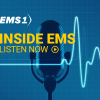Download this quick clip on iTunes, SoundCloud or via RSS feed
In this week’s Inside EMS podcast, hosts Chris Cebollero and Kelly Grayson sit down with Sean Eddy, a Texas paramedic and financial coach who says he’s cracked the code on how to live on an EMS salary.
“What kind of witchcraft is this?” Grayson joked.
Like many EMS providers, Eddy was living paycheck to paycheck and struggling with overdue bills, collection agencies and debt.
“I started to realize this is problem with my behavior, not with the industry.”
He began taking control of his budget, got his finances in line, and made a conscious decision to stay in EMS rather than leave the field for a higher salary. The key, he said, is to eliminate debt.
Grayson, however, pointed out that’s easier said than done.
“When it comes to setting a budget, this is a hard process to get into when you don’t have two nickels to rub together at the end of a paycheck,” Grayson said.
Eddy said it starts with knowing exactly how much you own, and figuring out what to do to get caught up. Start opening those overdue bills, call creditors and banks, and work with them to come up with a plan. Then look at your monthly expenses, and start hacking away. Eddy said he made a list of all his expenses, listed them in order of priority, and began eliminating luxuries like cable and eventually fast food.
“One of the biggest things for me was overdraft fees,” Eddy said. “Once I stopped that, I was saving over $400 a month.”
Becoming a money-smart medic, he said, comes down to being disciplined with your finances, making decisions about what’s important in your life, and taking responsibility for your spending. The overwhelming majority of those who make between $30,000 - $70,000 per year and are financially happy at their jobs – whether they’re in EMS or not – don’t have debt, save for emergencies and have a retirement plan.
Cebollero and Grayson also discussed the news that DCFEMS medical director Dr. David Miramontes has left for a position in San Antonio. Grayson wished him well in his new position, saying it will hopefully be a chance for D.C. EMS to get a fresh start.
“I will say Dr. Miramontes joins a long and distinguished list that has left DC EMS and Fire,” Grayson said.
They also talked about a bus driver who was threw a 10-year-old out of the way of a rolling bus, and died after being caught underneath and dragged for 40 feet.
Cebollero said he’s always impressed by civilians that risk their lives for others.
“How brave people get where they just kind of put themselves in those dangerous situations,” Cebollero said, “it just amazes me that the good-hearted people that are out there that wind up giving their lives to save others – it’s probably situations where they don’t even think about it.”
It’s also something that EMS encounters every day, but most responders at least acknowledge that every day they put on their uniform could be their last.
“When you’re a bus driver and you give that act of selflessness, that’s not something you’re expecting,” Grayson said.
And they talk about having a zero tolerance when it comes to using cellphones while driving after an Ohio EMT admitted to she was looking at her mobile GPS in a fatal crash.
“We need to be vigilant at all times,” Grayson said.
Here are links to some of the articles and other items mentioned on the show:


